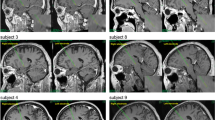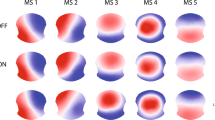Abstract
It has been suggested that slow oscillations in the subthalamic nucleus (STN) reflect top-down inputs from the medial prefrontal cortex, thus implementing behavior control. It is unclear, however, whether the STN oscillations are related to cortical activity in a bottom-up manner. To assess resting-state subcortico-cortical interactions, we recorded simultaneous scalp electroencephalographic activity and local field potentials in the STN (LFP-STN) in 11 patients with Parkinson’s disease implanted with deep brain stimulation electrodes in the on-medication state during rest. We assessed the cross-structural phase-amplitude coupling (PAC) between the STN and cortical activity within a wide frequency range of 1 to 100 Hz. The PAC was dominant between the δ/θ STN phase and β/γ cortical amplitude in most investigated scalp regions and between the δ cortical phase and θ/α STN amplitude in the frontal and temporal regions. The cross-frequency linkage between the slow oscillations of the LFP-STN activity and the amplitude of the scalp-recorded cortical activity at rest was demonstrated, and similar involvement of the left and right STNs in the coupling was observed. Our results suggest that the STN plays a role in both bottom-up and top-down processes within the subcortico-cortical circuitries of the human brain during the resting state. A relative left–right symmetry in the STN-cortex functional linkage was suggested. Practical treatment studies would be necessary to assess whether unilateral stimulation of the STN might be sufficient for treatment of Parkinson’s disease.



Similar content being viewed by others

Availability of Data and Material
The data and material that support the findings of this study are available from the corresponding author upon reasonable request.
Code Availability
The custom in-house MATLAB code is available from the corresponding author upon reasonable request. CARTOOL software by Denis Brunet is freely available https://sites.google.com/site/fbmlab/home.
References
Alonso-Frech F, Zamarbide I, Alegre M, Rodríguez-Oroz MC, Guridi J, Manrique M et al (2006) Slow oscillatory activity and levodopa-induced dyskinesias in Parkinson’s disease. Brain 129:1748–1757. https://doi.org/10.1093/brain/awl103
Bočková M, Rektor I (2019) Impairment of brain functions in Parkinson’s disease reflected by alterations in neural connectivity in EEG studies: a viewpoint. Clin Neurophysiol 130:239–247. https://doi.org/10.1016/j.clinph.2018.11.013
Bonnefond M, Kastner S, Jensen O (2017) Communication between brain areas based on nested oscillations. eNeuro. https://doi.org/10.1523/ENEURO.0153-16.2017
Brown P, Williams D (2005) Basal ganglia local field potential activity: character and functional significance in the human. Clin Neurophysiol 116:2510–2519. https://doi.org/10.1016/j.clinph.2005.05.009
Brown P, Oliviero A, Mazzone P, Insola A, Tonali P, Di Lazzaro V (2001) Dopamine dependency of oscillations between subthalamic nucleus and pallidum in Parkinson’s disease. J Neurosci 21:1033–1038. https://doi.org/10.1523/jneurosci.21-03-01033.2001
Bruns A, Eckhorn R (2004) Task-related coupling from high- to low-frequency signals among visual cortical areas in human subdural recordings. Int J Psychophysiol 51:97–116
Canolty RT, Edwards E, Dalal SS, Soltani M, Nagarajan SS, Kirsch HE et al (2006) High gamma power is phase-locked to theta oscillations in human neocortex. Science 313:1626–1628. https://doi.org/10.1126/science.1128115
Castrioto A, Meaney C, Hamani C, Mazzella F, Poon YY, Lozano AM et al (2011) The Dominant-STN phenomenon in bilateral STN DBS for Parkinson’s disease. Neurobiol Dis 41:131–137. https://doi.org/10.1016/j.nbd.2010.08.029
Cavanagh JF, Wiecki TV, Cohen MX, Figueroa CM, Samanta J, Sherman SJ, Frank MJ (2011) Subthalamic nucleus stimulation reverses mediofrontal influence over decision threshold. Nat Neurosci 14:1462–1467. https://doi.org/10.1038/nn.2925
Chen CC, Hsu YT, Chan HL, Chiou SM, Tu PH, Lee ST et al (2010) Complexity of subthalamic 13-35 Hz oscillatory activity directly correlates with clinical impairment in patients with Parkinson’s disease. Exp Neurol 224:234–240. https://doi.org/10.1016/j.expneurol.2010.03.015
Damborská A, Brázdil M, Rektor I, Janoušová E, Chládek J, Kukleta M (2012) Late divergence of target and nontarget ERPs in a visual oddball task. Physiol Res 61:307–318
Damborská A, Roman R, Brázdil M, Rektor I, Kukleta M (2016) Post-movement processing in visual oddball task—evidence from intracerebral recording. Clin Neurophysiol 127:1297–1306. https://doi.org/10.1016/j.clinph.2015.08.014
De Hemptinne C, Ryapolova-Webb ES, Air EL, Garcia PA, Miller KJ, Ojemann JG et al (2013) Exaggerated phase-amplitude coupling in the primary motor cortex in Parkinson disease. Proc Natl Acad Sci USA 110:4780–4785
Engel AK, Fries P (2010) Beta-band oscillations-signalling the status quo? Curr Opin Neurobiol 20:156–165. https://doi.org/10.1016/j.conb.2010.02.015
Fogelson N, Williams D, Tijssen M, Van Bruggen G, Speelman H, Brown P (2006) Different functional loops between cerebral cortex and the subthalmic area in Parkinson’s disease. Cereb Cortex 16:64–75. https://doi.org/10.1093/cercor/bhi084
Fries P (2005) A mechanism for cognitive dynamics: neuronal communication through neuronal coherence. Trends Cogn Sci 9:474–480. https://doi.org/10.1016/j.tics.2005.08.011
Germano IM, Gracies JM, Weisz DJ, Tse W, Koller WC, Olanow CW (2004) Unilateral stimulation of the subthalamic nucleus in Parkinson disease: a double-blind 12-month evaluation study. J Neurosurg 101:36–42. https://doi.org/10.3171/jns.2004.101.1.0036
Hammond C, Bergman H, Brown P (2007) Pathological synchronization in Parkinson’s disease: networks, models and treatments. Trends Neurosci 30:357–364. https://doi.org/10.1016/j.tins.2007.05.004
Jensen O, Mazaheri A (2010) Shaping functional architecture by oscillatory alpha activity: gating by inhibition. Front Hum Neurosci. https://doi.org/10.3389/fnhum.2010.00186
Jung TP, Makeig S, Westerfield M, Townsend J, Courchesne E, Sejnowski TJ (2000) Removal of eye activity artifacts from visual event-related potentials in normal and clinical subjects. Clin Neurophysiol 111:1745–1758. https://doi.org/10.1016/S1388-2457(00)00386-2
Kelley R, Flouty O, Emmons EB, Kim Y, Kingyon J, Wessel JR et al (2018) A human prefrontal-subthalamic circuit for cognitive control. Brain 141:205–216
Kronland-Martinet R, Morlet J, Grossmann A (1987) Analysis of sound patterns through walvelet transforms. Int J Pattern Recognit Artif Intell 1:273–302
Kukleta M, Bob P, Brázdil M, Roman R, Rektor I (2009) Beta 2-band synchronization during a visual oddball task. Physiol Res 58:725–732
Kukleta M, Bob P, Brázdil M, Roman R, Rektor I (2010) The level of frontal-temporal beta-2 band EEG synchronization distinguishes anterior cingulate cortex from other frontal regions. Conscious Cogn 19:879–886. https://doi.org/10.1016/j.concog.2010.04.007
Kukleta M, Damborská A, Turak B, Louvel J (2017) Evoked potentials in final epoch of self-initiated hand movement: a study in patients with depth electrodes. Int J Psychophysiol 117:119–125. https://doi.org/10.1016/j.ijpsycho.2017.05.004
Lakatos P, Karmos G, Mehta AD, Ulbert I, Schroeder CE (2008) Entrainment of neuronal oscillations as a mechanism of attentional selection. Science 320:110–113. https://doi.org/10.1126/science.1154735
Lalo E, Thobois S, Sharott A, Polo G, Mertens P, Pogosyan A, Brown P (2008) Patterns of bidirectional communication between cortex and basal ganglia during movement in patients with Parkinson disease. J Neurosci 28:3008–3016. https://doi.org/10.1523/JNEUROSCI.5295-07.2008
Lisman JE, Jensen O (2013) The theta-gamma neural code. Neuron 77:1002–1016
Litvak V, Jha A, Eusebio A, Oostenveld R, Foltynie T, Limousin P et al (2011) Resting oscillatory cortico-subthalamic connectivity in patients with Parkinson’s disease. Brain 134:359–374. https://doi.org/10.1093/brain/awq332
Marsden JF, Limousin-Dowsey P, Ashby P, Pollak P, Brown P (2001) Subthalamic nucleus, sensorimotor cortex and muscle interrelationships in Parkinson’s disease. Brain 124:378–388. https://doi.org/10.1093/brain/124.2.378
Moran A, Bergman H, Israel Z, Bar-Gad I (2008) Subthalamic nucleus functional organization revealed by parkinsonian neuronal oscillations and synchrony. Brain 131:3395–3409. https://doi.org/10.1093/brain/awn270
Onslow ACE, Bogacz R, Jones MW (2011) Quantifying phase–amplitude coupling in neuronal network oscillations. Prog Biophys Mol Biol 105:49–57
Oswal A, Brown P, Litvak V (2013a) Synchronized neural oscillations and the pathophysiology of Parkinson’s disease. Curr Opin Neurol 26:662–670. https://doi.org/10.1097/WCO.0000000000000034
Oswal A, Brown P, Litvak V (2013b) Movement related dynamics of subthalmo-cortical alpha connectivity in Parkinson’s disease. Neuroimage 70:132–142. https://doi.org/10.1016/j.neuroimage.2012.12.041
Perrin F, Pernier J, Bertrand O, Echallier JF (1989) Spherical splines for scalp potential and current density mapping. Electroencephalogr Clin Neurophysiol 72:184–187. https://doi.org/10.1016/0013-4694(89)90180-6
Saalmann YB, Pinsk MA, Wang L, Li X, Kastner S (2012) The pulvinar regulates information transmission between cortical areas based on attention demands. Science 337:753–756
Sharott A, Gulberti A, Zittel S, Tudor-Jones AA, Fickel U, Münchau A et al (2014) Activity parameters of subthalamic nucleus neurons selectively predict motor symptom severity in Parkinson’s disease. J Neurosci 34:6273–6285. https://doi.org/10.1523/JNEUROSCI.1803-13.2014
Shreve LA, Velisar A, Malekmohammadi M, Koop MM, Trager M, Quinn EJ et al (2017) Subthalamic oscillations and phase amplitude coupling are greater in the more affected hemisphere in Parkinson’s disease. Clin Neurophysiol 128:128–137. https://doi.org/10.1016/j.clinph.2016.10.095
Slowinski JL, Putzke JD, Uitti RJ, Lucas JA, Turk MF, Kall BA, Wharen RE (2007) Unilateral deep brain stimulation of the subthalamic nucleus for Parkinson disease. J Neurosurg 106:626–632. https://doi.org/10.3171/jns.2007.106.4.626
Smith Y, Bevan MD, Shink E, Bolam JP (1998) Microcircuitry of the direct and indirect pathways of the basal ganglia. Neuroscience 86:353–387. https://doi.org/10.1016/S0306-4522(98)00004-9
Stein E, Bar-Gad I (2013) Beta oscillations in the cortico-basal ganglia loop during parkinsonism. Exp Neurol 245:52–59. https://doi.org/10.1016/j.expneurol.2012.07.023
Stoffers D, Bosboom JLW, Deijen JB, Wolters EC, Berendse HW, Stam CJ (2007) Slowing of oscillatory brain activity is a stable characteristic of Parkinson’s disease without dementia. Brain 130:1847–1860
Stoffers D, Bosboom JLW, Deijen JB, Wolters EC, Stam CJ, Berendse HW (2008) Increased cortico-cortical functional connectivity in early-stage Parkinson’s disease: an MEG study. Neuroimage 41:212–222. https://doi.org/10.1016/j.neuroimage.2008.02.027
Voytek B, Canolty RT, Shestyuk A, Crone NE, Parvizi J, Knight RT (2010) Shifts in gamma phase-amplitude coupling frequency from theta to alpha over posterior cortex during visual tasks. Front Hum Neurosci. https://doi.org/10.3389/fnhum.2010.00191
Williams D (2002) Dopamine-dependent changes in the functional connectivity between basal ganglia and cerebral cortex in humans. Brain 125:1558–1569. https://doi.org/10.1093/brain/awf156
Zavala B, Brittain JS, Jenkinson N, Ashkan K, Foltynie T, Limousin P et al (2013) Subthalamic nucleus local field potential activity during the eriksen flanker task reveals a novel role for theta phase during conflict monitoring. J Neurosci 33:14758–14766. https://doi.org/10.1523/JNEUROSCI.1036-13.2013
Zavala BA, Tan H, Little S, Ashkan K, Hariz M, Foltynie T et al (2014) Midline frontal cortex low-frequency activity drives subthalamic nucleus oscillations during conflict. J Neurosci 34:7322–7333. https://doi.org/10.1523/JNEUROSCI.1169-14.2014
Zavala B, Damera S, Dong JW, Lungu C, Brown P, Zaghloul KA (2015) Human subthalamic nucleus theta and beta oscillations entrain neuronal firing during sensorimotor conflict. Cereb Cortex 27:496–508. https://doi.org/10.1093/cercor/bhv244
Zavala B, Tan H, Ashkan K, Foltynie T, Limousin P, Zrinzo L et al (2016) Human subthalamic nucleus-medial frontal cortex theta phase coherence is involved in conflict and error related cortical monitoring. Neuroimage 137:178–187. https://doi.org/10.1016/j.neuroimage.2016.05.031
Acknowledgements
The authors wish to thank Anne Johnson for providing language help.
Funding
The study was financially supported by the Czech Science Foundation Grant 21-25953S, by Grants FNS 192749 and CRSII5_170873, and by the Ministry of Education, Youth and Sports of the Czech Republic within the CEITEC 2020 (LQ1601) project.
Author information
Authors and Affiliations
Contributions
A.D. designed the study, collected and pre-processed the data, and wrote the initial draft of the manuscript. M.L. analyzed the data. D.B. and S.V. served as consultants for the data analysis and clinical issues, respectively. B.D., M.Ba, and M.Bo collected the data. I.R. developed the initial idea. All authors reviewed the manuscript.
Corresponding author
Ethics declarations
Competing interest
The authors declare no competing interests.
Ethics Approval and Consent to Participate
All participants gave their written informed consent prior to the experiment and the study received the approval of the ethics committee of St. Anne’s Hospital in Brno. All experiments in this study were performed in accordance with relevant guidelines and regulations.
Consent for Publication
Each author has read the complete manuscript and concurs with its content and publication.
Additional information
Handling Editor: Bin He.
Publisher's Note
Springer Nature remains neutral with regard to jurisdictional claims in published maps and institutional affiliations.
Supplementary Information
Below is the link to the electronic supplementary material.
10548_2021_822_MOESM1_ESM.png
Supplementary material 1 (PNG 854 kb) Supplementary Figure 1. Organization of selected scalp electrodes into regional sets. The data from 53 electrodes were pooled into 13 regions: Frontal-Left, Temporal-Left, Central-Left, Parietal-Left, Occipital-Left, Frontal-Right, Temporal-Right, Central-Right, Parietal-Right, Occipital-Right, Frontal, Parietal, Occipital
Rights and permissions
About this article
Cite this article
Damborská, A., Lamoš, M., Brunet, D. et al. Resting-State Phase-Amplitude Coupling Between the Human Subthalamic Nucleus and Cortical Activity: A Simultaneous Intracranial and Scalp EEG Study. Brain Topogr 34, 272–282 (2021). https://doi.org/10.1007/s10548-021-00822-8
Received:
Accepted:
Published:
Issue Date:
DOI: https://doi.org/10.1007/s10548-021-00822-8



